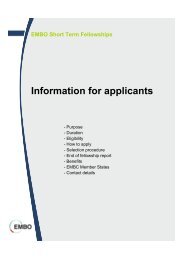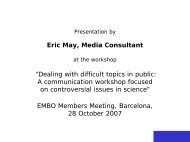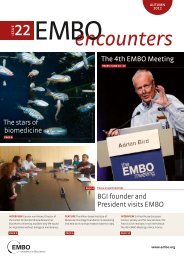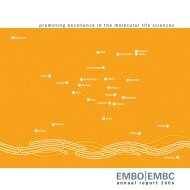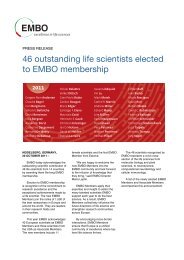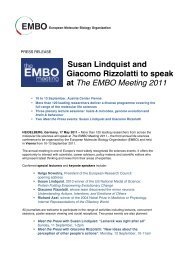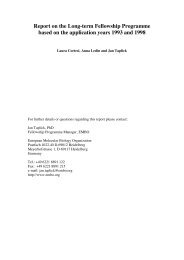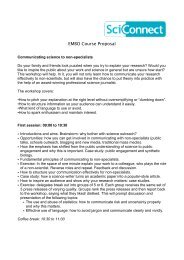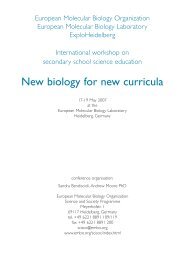EMBO Fellows Meeting 2012
EMBO Fellows Meeting 2012
EMBO Fellows Meeting 2012
Create successful ePaper yourself
Turn your PDF publications into a flip-book with our unique Google optimized e-Paper software.
Maria Ermolaeva<br />
<strong>EMBO</strong> <strong>Fellows</strong> <strong>Meeting</strong> <strong>2012</strong><br />
Systemic effects of tissue specific DNA damage<br />
Abstract<br />
DNA damage inflicted by external and internal insults is a common cause of cancer development. It also<br />
strongly contributes to other pathologies such as degenerative disorders and to the overall process of ageing.<br />
The types of DNA damage produced by different genotoxic stimuli as well as intracellular pathways involved in<br />
damage recognition, damage induced cell cycle arrest and DNA repair have been extensively characterized.<br />
However systemic effects of genome instability are not well understood and it remains unclear how<br />
neighboring tissues or even distant organs respond to localized DNA damage. Some clues about cell-nonautonomous<br />
outcome of genome instability recently came from studying the effect of UV light on the<br />
mammalian skin and through evaluating the consequences of genotoxic anti-tumor therapies. Yet the<br />
mammalian system is too complex to allow unveiling of the putative core mechanisms that mediate cell-nonautonomous<br />
DNA damage response. In our attempt to identify such core mechanisms we employed the<br />
nematode worm C. elegans as the model system. We took advantage of the fact that young adult worms show<br />
clear distinction between post mitotic soma and the germline where mitosis and meiosis occur actively. Due to<br />
indicated cell cycle differences the two compartments have different chromatin and DNA management status<br />
and exhibit distinct sensitivities to DNA damaging agents. The activities of the DNA damage checkpoint<br />
machinery and specific DNA repair pathways are also distinct in the soma and the germline. Therefore by using<br />
particular genotoxic stimuli and/or loss of function mutants for specific repair genes we could generate<br />
genome instability in the specific tissue of C. elegans. We then employed high throughput gene expression<br />
analysis in combination with several transgenic reporter systems based on the expression of a fluorescent<br />
protein to uncover and directly visualize what signaling cascades could be activated by DNA damage in a cellnon-autonomous<br />
manner.<br />
Maria A. Ermolaeva and Bjoern Schumacher<br />
CECAD Cologne. Institute for Genetics, University of Cologne. Zuelpicher Strasse 47a, 50674 Cologne, Germany<br />
14-17 June <strong>2012</strong>, Heidelberg, Germany




